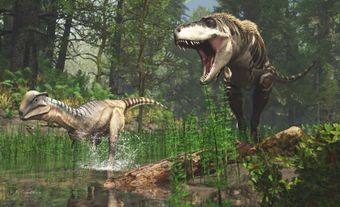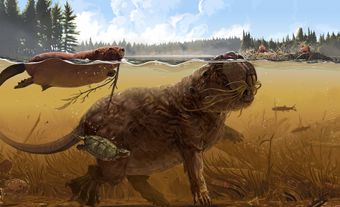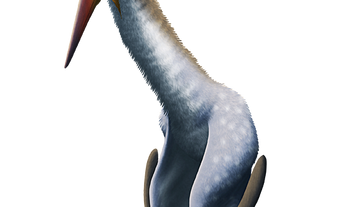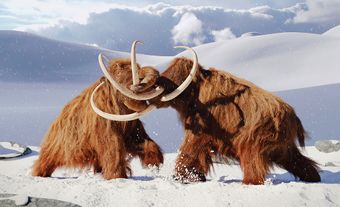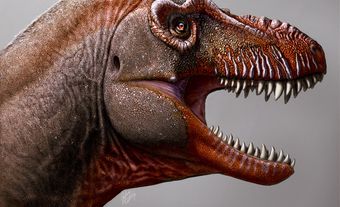Many animals found in Canada have become part of the country’s iconography. The beaver, the caribou, the loon and the polar bear, for example, all grace our currency, while moose, narwhals and others are pictured in regional emblems. If asked to name the creatures that roamed Canada long before these familiar ones, many might cite Tyrannosaurus rex or Triceratops, two of the 88 species of dinosaur found here (see Dinosaurs Found in Canada). But between dinosaurs and today’s beavers — a period of about 225 million years — whole ecosystems flourished and disappeared in Canada, and networks of animals with them. Below are five prehistoric Canadian animals. Two of them, Albertonectes and Cryodrakon, were contemporaries of the dinosaurs. Three others, the giant beaver, mammoth, and American mastodon, existed millennia later.
1. Giant Beaver

The giant beaver is an extinct rodent that lived in North America between 1.4 million and 10,000 years ago. It was a distant cousin to modern beavers, but in many ways may have been more similar to modern capybaras. The giant beaver was one of the largest rodents ever to roam the Earth, and one of approximately 30 extinct genera of beavers. Only two beaver species survive today: the North American beaver and the Eurasian beaver. In Canada, giant beaver fossils have been found on Indian Island, New Brunswick; in Toronto and near Highgate, Ontario; and in Old Crow Basin, Yukon.
2. Mammoth

Mammuthus is an extinct genus of proboscideans closely related to living elephants. (Proboscideans are members of the Proboscidea, a taxonomic group of mammals consisting of the living elephants and several extinct groups.) Two species of mammoth lived in Canada: the Columbian mammoth and the woolly mammoth. The earliest record of Mammuthus is from the Pliocene epoch (5.3 million–2.6 million years ago). Most mammoth populations were extinct by the end of the Pleistocene epoch (about 10,000 years ago). In Canada, mammoth fossils have been found in Yukon, the Northwest Territories, British Columbia, Alberta, Saskatchewan, Manitoba and Ontario.
3. American Mastodon

Like the mammoth, the American mastodon is an extinct species of proboscidean. Although they likely resembled mammoths and elephants in external appearance, American mastodons belong to the taxonomic family Mammutidae and mammoths and elephants to Elephantidae. In Canada, fossil evidence of American mastodons is restricted to the latter portions of the Pleistocene epoch (2.68 million–10,000 years ago). Paleontologists have recovered fossil remains of the American mastodon from every territory except Nunavut, and every province except Newfoundland and Labrador and Prince Edward Island.
4. Albertonectes

Albertonectes (pronounced al-BER-toe-NEK-teez) is a genus of plesiosaur. Plesiosaurs were not the same as dinosaurs, though they are sometimes mistakenly placed in the same category. Dinosaurs lived on land, while plesiosaurs were air-breathing reptiles that flourished in the world’s oceans during the same era. Specifically, Albertonectes lived during the Late Cretaceous period (100.5 million–66 million years ago). To date, Albertonectes fossils have only been found in Alberta, south of Lethbridge. Albertonectes had 76 neck bones, the most of any animal.
5. Cryodrakon

Cryodrakon (pronounced CRY-oh-DRAH-kon) is a genus of giant pterosaur. (Pterosaurs are flying reptiles that lived during the same period as dinosaurs.) It lived toward the end of the Cretaceous period (76.5 million–74.8 million years ago) in southern Alberta. With a wingspan of at least 10 m — the equivalent of a small airplane — Cryodrakon was one of the largest flying animals ever known. It is also one of the first giant pterosaurs to have ever lived and the only pterosaur discovered in Canada.

 Share on Facebook
Share on Facebook Share on X
Share on X Share by Email
Share by Email Share on Google Classroom
Share on Google Classroom
